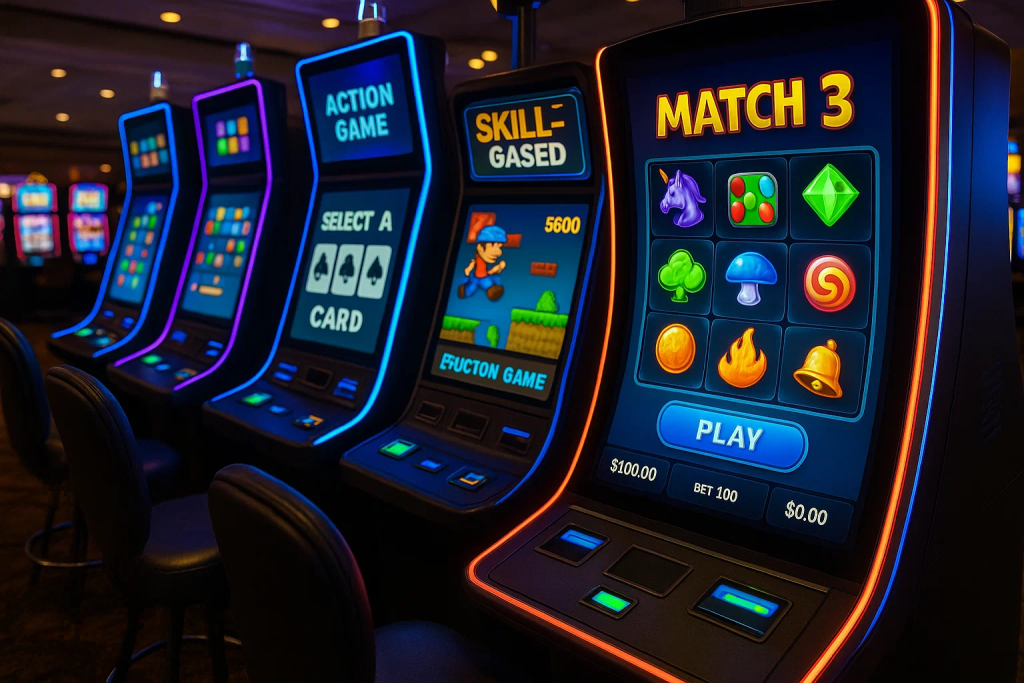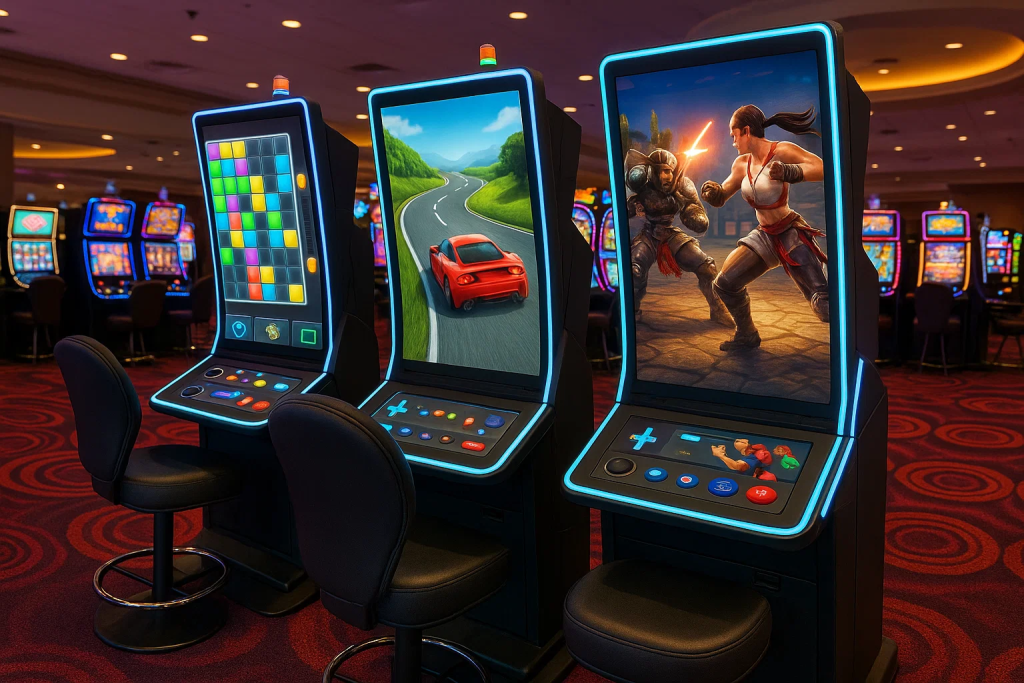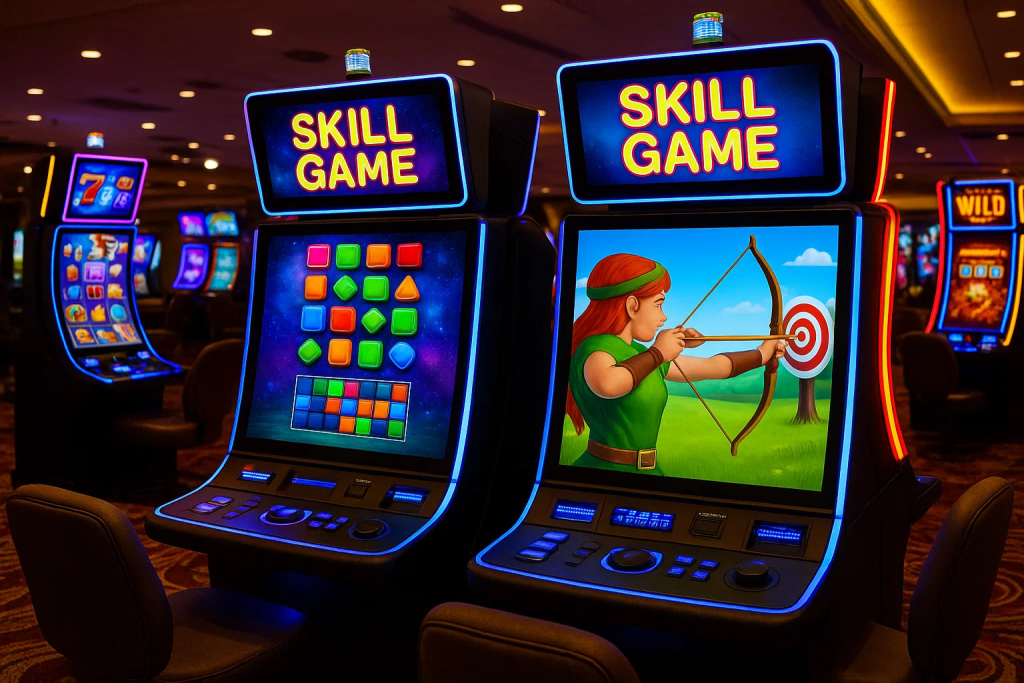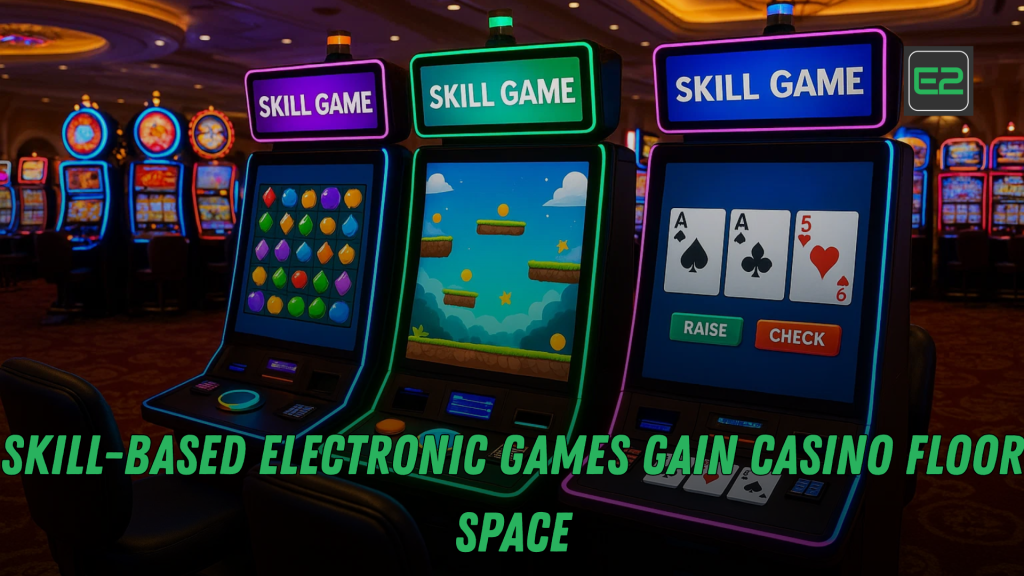Table of Contents
Executive Summary
Skill-based electronic games (SBEs)—sometimes called hybrid slots, arcade-inspired EGMs, or interactive step-bonus titles—are no longer experimental novelties. They’re a strategic response to a changing audience, a data-rich product for marketers, and a differentiator for properties fighting to grow time-on-device without relying purely on volatility spikes. Properly built and placed, SBEs:
- Convert experience-seeking Millennials and Gen Z who want agency, mastery, and social proof.
- Generate stickier loyalty by tying skill progression to tier points, cosmetics, and event invites.
- Offer richer telemetry (accuracy, reaction time, path choices) to refine promos and merch.
- Coexist with classic slots rather than cannibalize them—when operators zonalize the floor, tune RTP/volatility, and market clearly.
This guide is a complete playbook—from game design and floor economics to compliance, cashless, responsible gambling, marketing, KPIs, pilot rollout, and future trends. Use it to de-risk your next move and turn curiosity into a repeatable revenue engine.
Note: Always align with your jurisdiction’s gaming regulations and promote responsible play. The frameworks here are vendor-agnostic and adaptable to most markets.

1) What Exactly Are Skill-Based Casino Electronic Games?
Definition: SBEs are electronic casino games that blend chance with player skill during one or more stages of the experience. The “base spin” may still be RNG-driven (to satisfy gaming rules), but player input—timing, aim, route selection, puzzle solving—can influence bonus outcomes within defined parameters.
Common SBE formats:
- Timed Aim/Touch Challenges: Hit targets, slice objects, align symbols under a clock.
- Path & Puzzle Bonuses: Choose routes, unlock gates, solve pattern logic for enhanced multipliers.
- Arcade-Inspired Mini-Games: Quick waves of enemies, obstacle dodging, rhythm taps.
- Team or Head-to-Head Rounds (as allowed): Rotating leaderboards, asynchronous challenges, or live side-by-side modes.
Why players care:
- Agency: Decisions feel meaningful.
- Mastery & Progress: Skill ramps and visible improvement.
- Share-worthy Moments: Clips for TikTok/Reels; on-machine leaderboards.
- Crossover Appeal: From mobile gamers and arcade nostalgics to esports fans exploring casinos.
2) The Casino Demand Shift: Who Plays and Why?
2.1. The new casino guest
- Millennials/Gen Z value experiences, social currency, and fair-feeling mechanics.
- They grew up on mobile, console, and PC games; tapping a spin button alone is less sticky.
- They respond to progression systems (levels, cosmetics, badges) and seasonal events.
2.2. The use cases
- Pre-concert and pre-club traffic: Quick bursts, high energy, photogenic cabinets.
- Resort integrated plays: Earn & burn across hotel, F&B, shows via wallet + loyalty.
- Esports weekends: Crossover traffic seeking familiar feedback loops.
- Locals markets: Repeat players who desire novelty but still want predictable session budgets.
Key insight: SBEs add a layer to the floor mix. They don’t replace classic high-denom reels or video poker; they pull in adjacent segments and give marketing fresh storytelling.
3) The Casino Business Case: Revenue, Mix, and ROI
3.1. Where does the money come from?
- Core handle: Base wagers, bonus engagements, and repeat sessions as players chase mastery.
- Ancillary spend: F&B uplift, merch, VIP events tied to leaderboards, paid cosmetics (if allowed).
- Sponsorable moments: Seasonal “Skill Fest,” cabinet skins, and influencer mini-tournaments.
3.2. Mix strategy
- Allocate 5–15% of floor to SBEs in year 1, rising to 15–25% if KPIs hit thresholds.
- Build micro-zones (6–20 machines) with thematic lighting/audio to create a distinct feel.
- Flank SBE clusters with social seating (banquettes, standing rails) and spectator sightlines.
3.3. ROI levers
- Cabinet utilization: Track occupancy by hour; adjust promos to fill cold periods.
- Time-on-device (ToD): Skill tends to extend ToD without spiking burn rate—good for F&B synergy.
- Return-visit rate: Tie progression to returning rather than marathon sessions.
4) Casino Design Principles: Fun First, Fair Always, Friction Never
4.1. The “F3” framework
- Fun: Instant clarity, escalating challenges, and visceral feedback (lights, haptics, sound).
- Fair: Transparent rules, tuned difficulty curves, no “gotchas” that feel rigged.
- Frictionless: From wallet connect to bonus entry, keep tap-count low and latency tight.
4.2. Anatomy of a sticky SBE
- On-ramp: One-screen tutorial (GIF-style). Player must succeed in 10–15 seconds on first try.
- Three-act challenge: Easy → moderate → clutch moment; increasing reward intensity.
- Mercy mechanics: Near-miss conversion, extra life from loyalty tier, teammate assist (if legal).
- Progression: XP bar, cosmetic unlocks, weekly quests (“Score 300+ in bonus 3 times”).
- Social proof: Leaderboards, post-bonus photo mode, QR to share highlights.
4.3. Difficulty tuning & RTP
- Keep base RTP within regulatory constraints; allow skill influence to modulate bonus EV within approved bounds.
- Design volatility bands (Chill / Standard / Hot) that players can choose—not hidden.
5) Casino Compliance & Responsible Gambling: Non-Negotiables
- Document where chance ends and skill begins; submit math models and test scripts.
- Keep RNG audit trails; version-lock math to cabinet firmware.
- Offer session clocks, budget reminders, self-set limits, and cool-off buttons.
- Use clear odds language; don’t imply skill can overcome house advantage beyond verified ranges.
- Respect age gating and KYC rules; integrate with AML/CFT transaction monitoring if cashless.
6) Casino Cashless & Loyalty: Make the Wallet the Hub
- At-cabinet QR/NFC for instant wallet connect; display live balance and loyalty XP.
- Allow earn & burn across F&B and retail; reward skill milestones with tier points/cosmetics.
- Mobile app should show match history, replays, and quests—not just balances.
- Push responsible-play nudges in-app (limit reminders, time-out suggestions after long bursts).
7) Casino Data & Analytics: From Spins to Insights
Event streams to capture:
- Time-to-first-win, bonus entry frequency, challenge completion rate, accuracy %, reaction time, preferred difficulty band.
- Session length, inter-session interval, cohort LTV by quest participation vs. non-quest.
Dashboards that matter:
- Acquisition: % new-to-floor players starting in SBE zone.
- Engagement: Average challenges per session; quest completion rates.
- Monetization: Handle/hour; F&B linkage; wallet cross-spend.
- Safety: Limit-setting rate; cool-off usage; average session length by age band.
Use data to iterate difficulty, retheme stale cabinets, and personalize offers (e.g., “Precision Challenge Weekend” for high-accuracy cohorts).

8) Casino Floor Architecture & UX: Build a Stage, Not a Corner
- Placement: Near bars, stages, and foot-traffic spines; far enough from high-denom quiet zones.
- Sightlines: Cabinets angled outward; overhead signage with motion graphics.
- Sound discipline: Energetic but bounded; don’t drown adjacent banks.
- Social perches: Rail tables, phone charging, selfie spots with branded backdrops.
- Wayfinding: Color-coded carpets or LED strips guiding guests to “Skill Zone.”
9) Casino Marketing Playbook: Tell the Right Story, To the Right Audience
9.1. Messaging pillars
- Agency: “Your skill, your bonus.”
- Progress: “Level up every weekend; unlock exclusive cosmetics.”
- Social: “Top the leaderboard; bring friends.”
- Safety: “Set limits in two taps. Play your pace.”
9.2. Tactics
- Creator nights: Invite streamers to short head-to-head runs (within rules).
- Quests calendar: Weekly missions; monthly themed cups; season finales.
- Push/Pull: App push for nearby quests; pull content via IG/TikTok clips with auto-subtitles.
- On-floor ambassadors: 90-second demos; “first-time success” coaching for hesitant guests.
10) Casino Operations: Training, Support, and Issue Playbooks
- Team training: Floor staff practice the game; know tutorial scripts and safety features.
- Issue trees:
- Player confusion → trigger tutorial replay → offer practice mode (if allowed).
- Dispute on scoring → pull replay log → explain rules plainly.
- Heat/crowd overflow → deploy queue markers and staggered mini-events.
- Maintenance: Keep touchscreens calibrated, fans clean, buttons responsive; SBE users are sensitive to input lag.
11) KPIs that Prove It Works
- Adoption: % of unique wallets playing SBE per week; % new-to-floor in SBE first.
- Engagement: Avg. challenges per session; return within 7 days; quest participation.
- Revenue quality: Handle/hour; ToD; F&B cross-spend; comp redemption efficiency.
- Responsibility: Limit-setting rate; cool-off usage; session length distribution.
- Asset health: Input-latency incidents; touchscreen calibration passes; cabinet downtime.
Set phase-gate targets (e.g., adoption ≥18%, return-within-7-days ≥30%, limit-setting ≥20%) before expanding the zone.
12) Casino Pilot to Scale: A 90-Day Rollout
Days 1–30 – Foundations
- Pick 3–5 SBE titles with varied mechanics (aim, puzzle, rhythm).
- Carve a 10–12 unit micro-zone; add signage, seating, and QR onboarding.
- Approve math + compliance; script tutorials; train staff.
Days 31–60 – Soft Launch
- Launch to loyalty tiers first; run two creator nights.
- Start quests calendar; enable wallet-linked rewards and limit settings.
- Review dashboards weekly; tune difficulty and audio.
Days 61–90 – Public Push & Evaluate
- Go public with a Skill Weekend; livestream highlights to in-house screens.
- Hit KPIs; decide expansion: +8–12 cabinets or re-theme underperformers.
- Publish a “What We Changed” note—transparency builds trust.
13) Myths vs. Facts
- Myth: Skill games will cannibalize high-denom slots.
Fact: When zoned and messaged properly, SBEs add new segments and dayparts. - Myth: Players think it’s rigged if they miss.
Fact: Clear tutorials, visible rules, and replay logs turn misses into challenges, not complaints. - Myth: Only gamers care.
Fact: Arcade nostalgia and simple, kinetic challenges appeal across ages—if onboarding is friendly. - Myth: Responsible tools kill revenue.
Fact: Limits and nudges sustain lifetime value by preventing burnout and regret.
14) Future Trends: What’s Next on the Floor?
- Co-op boss rounds (where legal): Short, spectacle moments for nearby players.
- AR overlays: Phone-assisted filters for shareable clips.
- Cosmetics economy: Non-monetary skins tied to quests or tier milestones.
- Esports crossovers: Branded weekends with pro meet-ups and creator leaderboards.
- Haptics 2.0: Seat rumble, localized wind/scent modules (used sparingly).
15) Case Studies (Hypothetical Illustrations)
Resort A (Tourist market): 12-cab SBE zone near the theatre increased pre-show gaming by 24%, F&B uplift +11%, average session +9 minutes. Limit-setting adoption hit 22% after staff trained to promote it as a feature.
Locals B (Suburban): Weekly “Puzzle Cup” with quiet hours double points brought 30% new-to-floor guests. Return-within-7-days up 34% for SBE cohorts vs. standard slots.
Downtown C (Young demo): Creator night + “first-try tutorial” raised first-time success to 81%; dispute calls fell 40% after adding replay explainer screens.
16) Risk & Resilience: Build the Guardrails
- Difficulty drift: Continuous A/B checks; cap maximum skill effect within approved RTP bands.
- Latency complaints: SLA for input lag tickets; proactive calibration schedule.
- Crowding: Queue markers, time-boxed events, alternate play suggestions to adjacent banks.
- Reg updates: Track rule changes; maintain a compliance change log per title.
17) The Operator’s Checklist
- Zone designed with sightlines, seating, QR onboarding.
- 3+ game types (aim/puzzle/rhythm) with quick tutorials.
- Wallet + loyalty fully integrated (earn & burn).
- Responsible-play UI live (limits, timers, cool-off).
- Dashboards for adoption, engagement, revenue quality, safety.
- Staff trained on demos, safety, and dispute scripts.
- Creator/quest calendar published 60 days out.
Call to Action
If you’re ready to transform curiosity into repeat engagement, start with a 10-cab skill zone, pair it with wallet onboarding, and publish a quests calendar that respects time and budgets. Train your ambassadors, measure honest KPIs, and iterate in the open. Players will come for the novelty—but they’ll stay for agency, fairness, and progression.
Want a tailor-made floor map, quest calendar, and KPI sheet for your property? Share your floor size, guest mix, and current tech stack—I’ll craft a 90-day SBE launch plan you can execute.

Final Word
Skill-based electronic games (SBEs)—hybrid slot-style titles that blend RNG-led chance with player-influenced bonus skill—are moving from novelty to strategy on casino floors. Properly designed and placed, SBEs attract Millennials and Gen Z who value agency, mastery, social proof, and progression, while coexisting with classic slots. They expand the audience, extend time-on-device (without excessive burn), enrich loyalty data, and create sponsorable moments.
Business case & mix. Start with 5–15% of the floor and scale to 15–25% if KPIs hit targets. Build micro-zones (6–20 cabinets) near entertainment hubs, with clear sightlines, social seating, and thematic lighting. Revenue comes from core handle, repeat play driven by mastery/quests, F&B uplift, merch, and creator events. Focus ROI on cabinet utilization, time-on-device, return-visit rate, and safe engagement.
Design principles (F3: Fun, Fair, Frictionless). Deliver instant clarity, escalating challenges, and transparent rules. Keep tutorials to a single screen, offer three-act bonus arcs, mercy mechanics, visible leaderboards, and cosmetic/progression systems. Tune difficulty within approved RTP bands and allow players to choose volatility/difficulty openly.
Compliance & responsibility. Document where chance ends/skill begins, submit math models, lock RNG versions, and embed session clocks, budget reminders, self-limits, and cool-offs. Align cashless/KYC/AML if wallets are integrated, and message odds honestly.
Cashless, loyalty, and data. Make the wallet the hub: QR/NFC connect, live balances, and XP on cabinet; app shows replays, quests, and limits. Track accuracy, reaction time, challenge completion, session patterns, quest participation, F&B cross-spend, and limit usage to iterate difficulty, themes, and offers responsibly.
Floor UX & marketing. Treat SBEs as a stage: angled cabinets, motion signage, controlled audio, charging rails, selfie spots, and wayfinding. Market with creator nights, weekly quests, seasonal cups, short-form highlight clips, and on-floor ambassadors who give 90-second demos. Message pillars: Agency, Progress, Social, Safety.
Ops, KPIs & rollout. Train staff to demo, resolve scoring disputes, and promote safety tools. Core KPIs: adoption (% wallets playing), return-within-7-days, handle/hour, time-on-device, F&B linkage, limit-setting, cool-off usage, input-latency incidents, and downtime. Rollout plan: 90 days from foundations (zone, titles, training) to soft launch (loyalty first, creator nights) to public push (Skill Weekend, KPI review). Scale only after hitting phase gates (e.g., adoption ≥18%, returns ≥30%, limit-setting ≥20%).
Philippine Slot Machines Go Cashless: Brilliant E-Wallet Strategy
Risk & future. Manage difficulty drift, latency, crowding, and regulatory updates. Keep content fresh via re-skins, rotating rules, and transparent patch notes. Looking ahead: co-op boss rounds (where legal), AR overlays, cosmetics economies, esports crossovers, and refined haptics. Bottom line: clarity, agency, and care turn SBEs into a repeatable revenue engine—and a reputation for modern, responsible fun.
Frequently Asked Questions (FAQ)
1) Are skill-based electronic games legal in my market?
Most jurisdictions allow chance-led games with skill-influenced bonuses within regulated RTP bands. Check your regulator’s technical standards and submit math + test cases. Always align messages so players understand where skill matters and where chance rules.
2) Won’t SBEs confuse slot players?
Use one-screen tutorials, staff demos, and a “win on your first try” practice step (if permitted). Clearly label difficulty bands and keep base play one-tap simple. Confusion drops fast when onboarding is friendly.
3) How do we prevent problem gambling while encouraging mastery?
Bake in session clocks, limit settings, cool-offs, and opt-outs. Message “play your pace”. Reward return visits via quests rather than marathon sessions. Responsible design protects LTV and trust.
4) What KPIs decide whether to expand the zone?
Aim for adoption ≥18% of active wallets weekly, return-within-7-days ≥30%, limit-setting ≥20%, handle/hour comparable to adjacent banks, and positive F&B cross-spend. Hit these for 4–6 weeks before adding cabinets.
5) How do we keep SBEs fresh after launch?
Run seasonal re-skins, rotate challenge rules, publish quests calendars, and host creator nights. Watch telemetry—if accuracy surges, gently raise the skill ceiling; if completion collapses, widen timing windows.
